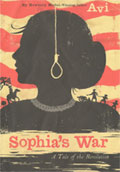 The most difficult aspect of Sophia’s War is the commingling of fact and fiction. The story of Benedict Arnold’s treason, and John André’s fate, is not just well known, it has been researched and detailed to an extraordinary degree. One of the books I used to research the event provided photographs and descriptions of everywhere André went during that extraordinary moment—virtually step by step. Moreover, my attempt to describe New York City during the British occupation (1776–7183) is based on detailed research that has been done by others. It is all as “correct” as I could write it.
The most difficult aspect of Sophia’s War is the commingling of fact and fiction. The story of Benedict Arnold’s treason, and John André’s fate, is not just well known, it has been researched and detailed to an extraordinary degree. One of the books I used to research the event provided photographs and descriptions of everywhere André went during that extraordinary moment—virtually step by step. Moreover, my attempt to describe New York City during the British occupation (1776–7183) is based on detailed research that has been done by others. It is all as “correct” as I could write it.
But Sophia herself, and her story, is very much fiction. How can the two connect? It is because as the historians of the events record, there are two key moments in the Arnold/André saga that have never been satisfactorily illuminated. Historians speak of “luck,” “fate,” and “coincidence.” Perhaps. But it is just at those points that I have been able to create a character, motive, and means, for these mysterious events to be explained. Not the least of what makes it all work is that Sophia does not want to be noticed, is not noticed, and indeed, cannot be noticed in the context of who and what she is—an independent young woman. It’s very much like that wonderful book title, Anonymous Was a Woman.
Ralph Waldo Emerson said (if I have it right) “History is biography.” Sophia’s War is Sophia’s autobiography. Just don’t look for her in history books. You can only find her here. “The writer’s task,” as I once heard Paula Fox say, “is to imagine the truth.”
3 thoughts on “Commingling fact and fiction”
Loved this! Thanks for sharing. I’m working on a Spanish-American war novel right now so this helps.
I so agree with you i love this book it is the best book ever
Thank you!